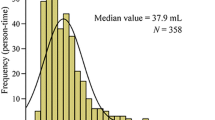Abstract
Purpose
We aimed to analyze prognostic factors in patients with nasopharyngeal carcinoma (NPC) treated with concurrent chemotherapy and intensity-modulated radiotherapy (IMRT); in addition, we aimed to elucidate the value of primary gross tumor volume (GTVp) in predicting prognosis of patients.
Methods
Between February 2001 and December 2008, 321 patients with NPC treated with concurrent chemotherapy and IMRT were analyzed retrospectively. GTVp was calculated from treatment planning computed tomography scans. A receiver operating characteristics (ROC) curve was used to determine the best cutoff point of GTVp.
Results
The 5-year local failure-free survival (LFFS), distant metastasis-free survival (DMFS), disease-free survival (DFS), and overall survival (OS) for NPC patients were 93.8, 80.1, 73.0, and 83.7 %, respectively. Univariate and multivariate analyses indicated that GTVp had exhibited a statistically significant correlation with LFFS, DMFS, DFS, and OS (P < 0.05, all), whereas T classification was not an independent prognostic factor. According to ROC curve analysis, 49 and 19 mL were determined as the cutoff points of GTVp for local control and distant metastasis, respectively. Based on this, 321 patients were divided into three volume subgroups. LFFS, DMFS, DFS, and OS demonstrated significant differences among patients in different volume subgroups (P < 0.001, all) and were superior to T classification for predicting prognosis of NPC patients.
Conclusions
Primary gross tumor volume is an independent prognostic factor in local control, distant metastasis, disease-free survival, and overall survival in NPC. An adjusted TNM staging system that includes GTVp as a quantitative indicator to evaluate prognosis is warranted.



Similar content being viewed by others
References
Baujat B, Bourhis J, Chan AT et al (2006) Chemotherapy in locally advanced nasopharyngeal carcinoma: an individual patient data meta-analysis of eight randomized trials and 1753 patients. Int J Radiat Oncol Biol Phys 64:47–56
Bentzen SM, Thames HD (1996) Tumor volume and local control probability: clinical data and radiobiological interpretations. Int J Radiat Oncol Biol Phys 36:247–251
Brenner DJ (1993) Dose, volume, and tumor-control predictions in radiotherapy. Int J Radiat Oncol Biol Phys 26:171–179
Chang CC, Chen MK, Liu MT et al (2002) The effect of primary tumor volumes in advanced T-staged nasopharyngeal tumors. Head Neck 24:940–946
Chen MK, Chen TH, Liu JP et al (2004) Better prediction of prognosis for patients with nasopharyngeal carcinoma using primary tumor volume. Cancer 100:2160–2166
Chen L, Liu LZ, Mao YP et al (2011) Grading of MRI-detected skull-base invasion in nasopharyngeal carcinoma and its prognostic value. Head Neck 33:1309–1314
Chua DT, Sham JS, Kwong DL et al (1997) Volumetric analysis of tumor extent in nasopharyngeal carcinoma and correlation with treatment outcome. Int J Radiat Oncol Biol Phys 39:711–719
Dubben HH, Thames HD, Beck-Bornholdt HP (1998) Tumor volume: a basic and specific response predictor in radiotherapy. Radiother Oncol 47:167–174
Johnson CR, Thames HD, Huang DT et al (1995) The tumor volume and clonogen number relationship: tumor control predictions based upon tumor volume estimates derived from computed tomography. Int J Radiat Oncol Biol Phys 33:281–297
Kam MK, Teo PM, Chau RMC et al (2004) Treatment of nasopharyngeal carcinoma with intensity-modulated radiotherapy: the Hong Kong experience. Int J Radiat Oncol Biol Phys 60:1440–1450
Langendijk JA, Leemans CR, Buter J et al (2004) The additional value of chemotherapy to radiotherapy in locally advanced nasopharyngeal carcinoma: a meta-analysis of the published literature. J Clin Oncol 22:4604–4612
Lee N, Xia P, Quivey JM et al (2002) Intensity-modulated radiotherapy in the treatment of nasopharyngeal carcinoma: an update of the UCSF experience. Int J Radiat Oncol Biol Phys 53:12–22
Lee AW, Lau WH, Tung SY et al (2005) Preliminary results of a randomized study on therapeutic gain by concurrent chemotherapy for regionally-advanced nasopharyngeal carcinoma: NPC-9901 Trial by the Hong Kong Nasopharyngeal Cancer Study Group. J Clin Oncol 23:6966–6975
Lin JC, Jan JS, Hsu CY et al (2003) Phase III study of concurrent chemoradiotherapy versus radiotherapy alone for advanced nasopharyngeal carcinoma: positive effect on overall and progression-free survival. J Clin Oncol 21:631–637
Lin S, Pan J, Han L et al (2009) Nasopharyngeal carcinoma treated with reduced-volume intensity-modulated radiation therapy: report on the 3-year outcome of a prospective series. Int J Radiat Oncol Biol Phys 75:1071–1078
Palazzi M, Orlandi E, Bossi P et al (2009) Further improvement in outcomes of nasopharyngeal carcinoma with optimized radiotherapy and induction plus concomitant chemotherapy: an update of the Milan experience. Int J Radiat Oncol Biol Phys 74:774–780
Shen C, Lu JJ, Gu Y et al (2008) Prognostic impact of primary tumor volume in patients with nasopharyngeal carcinoma treated by definitive radiation therapy. Laryngoscope 118:1206–1210
Sobin LH, Wittekind CL (eds) (2002) TNM classification of malignant tumors, 6th edn. Wiley, New York
Tham IW, Hee SW, Yeo RM et al (2009) Treatment of nasopharyngeal carcinoma using intensity-modulated radiotherapy-the National Cancer Centre Singapore experience. Int J Radiat Oncol Biol Phys 75:1481–1486
Wei WI, Sham JS (2005) Nasopharyngeal carcinoma. Lancet 365:2041–2054
Willner J, Baier K, Pfreundner L et al (1999) Tumor volume and local control in primary radiotherapy of nasopharyngeal carcinoma. Acta Oncol 38:1025–1030
Wolden SL, Chen WC, Pfister DG et al (2006) Intensity-modulated radiation therapy (IMRT) for nasopharynx cancer: update of the Memorial Sloan-Kettering experience. Int J Radiat Oncol Biol Phys 64:57–62
Xiao WW, Huang SM, Han F et al (2011) Local control, survival, and late toxicities of locally advanced nasopharyngeal carcinoma treated by simultaneous modulated accelerated radiotherapy combined with cisplatin concurrent chemotherapy: long-term results of a phase 2 study. Cancer 117:1874–1883
Acknowledgments
This work was supported by the Planned Science and Technology Project of Guangdong Province (No. 2010B080701016 and No. 2012B031800301).
Conflict of interest
None.
Author information
Authors and Affiliations
Corresponding author
Rights and permissions
About this article
Cite this article
Wu, Z., Su, Y., Zeng, RF. et al. Prognostic value of tumor volume for patients with nasopharyngeal carcinoma treated with concurrent chemotherapy and intensity-modulated radiotherapy. J Cancer Res Clin Oncol 140, 69–76 (2014). https://doi.org/10.1007/s00432-013-1542-x
Received:
Accepted:
Published:
Issue Date:
DOI: https://doi.org/10.1007/s00432-013-1542-x




